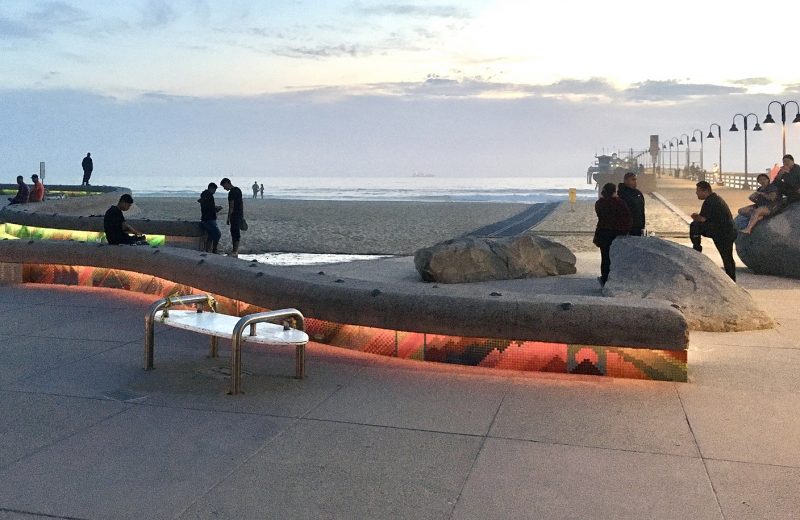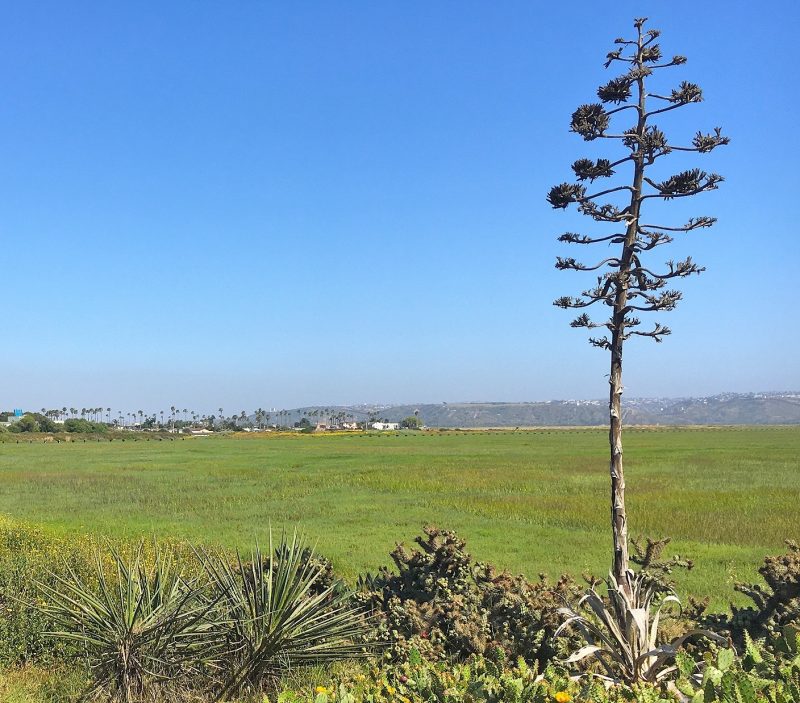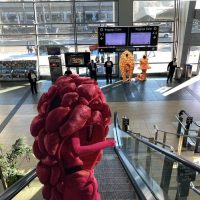Descripción del evento
Escondida en la esquina suroeste de los Estados Unidos, la pequeña localidad de Imperial Beach se ubica justo al norte de la frontera con México, lo que la hace la ciudad de California localizada más al sur. Mientras IB (como la llaman los habitantes locales) atrae a surfistas, observadores de aves y a los que van a la playa, también es un lugar que cuenta con tesoros de diseño arquitectónico y de paisaje dignos de recordar. Realiza un recorrido autoguiado de IB que te llevará al Outdoor Surfboard Museum, a las queridas instalaciones de arte público Surfhenge e Illuminations y al Tijuana Estuary Visitor Center del que se puede ver una de las dos reservas naturales de California.
Esta función se lanzará en la página del evento el 9 de septiembre y estará disponible toda la semana.
Este programa será presentado en inglés.
Imperial Beach, South Bay
Tucked into the southwestern corner of the United States, the small seaside town of Imperial Beach lies just north of the international border with Mexico making it the southernmost city in California. While IB, as the locals call it, attracts surfers, birdwatchers, and beachgoers, it’s also home to some memorable architectural, landscape, and environmental design gems. This tour features the Outdoor Surfboard Museum; two public art installations, Surfhenge and Illuminations; and the Tijuana Estuary Visitor Center, which overlooks one of California’s two nature reserves.

Outdoor Surfboard Museum
Directions:
Drive south on Interstate 5. Take the Palm Avenue exit. Turn left to continue on Palm Avenue at the “Palm Avenue, Beaches, Pier” sign. The Outdoor Surfboard Museum begins at 3rd Avenue and runs along both sides of Palm Avenue all the way to Seacoast Drive.
The Imperial Beach Business District invited Calvin Woo of CWA, Inc. to pitch an idea that would attract visitors to linger along Palm Avenue. Woo, who grew up in Hawaii riding big waves on a variety of surfboard types, proposed an open-air exhibition of surfboard history that would embrace Imperial Beach’s contributions to surf culture. The Outdoor Surfboard Museum, installed in 2006, chronicles innovative shifts in surfboard design through 25 true-to-size surfboard shapes ranging from the 16-foot ancient Hawaiian redwood boards to Jay Novak’s 1985 6-foot-1 Swallow Tail. Each piece was constructed by Fabrication Arts from 2 ½-inch tubular stainless steel for its strength then painted red with durable automotive paint to withstand the sun and salty air as well as to contrast with the surroundings. All of the actual-sized surfboards, including nine by local shapers, have a companion shadow that’s sandblasted into the sidewalk at a 45-degree angle from the upright model. Hop on the shadow board, get into position, and imagine an exhilarating ride on Imperial Beach’s legendary big-wave surf break, the Tijuana Slough.
A 10-inch circular brushed stainless steel plaque is welded to each surfboard. The year the surfboard was designed is etched on one side of the plaque with blue epoxy paint. The opposite side identifies the board’s length and name of the designer followed by the designated shape or style and original material from which the board was made. Susan Merritt of CWA, Inc. designed the plaque’s layout and typography choosing Helvetica Rounded, Linotype Design Studio’s 1978 variant of Helvetica designed in 1957 by Max Miedinger. Its casual appearance suits IB’s laid back temperament and reflects the tubular character of the surfboard forms. Using the bold condensed version ensured that all the text would fit comfortably and be easy to read.
While leisurely meandering along Palm Avenue, learn about the history of surfboard design and get to know the shapers who sought an ever faster, smoother ride by design.



Public Art on the Plaza: Surfhenge and Illuminations
Directions:
Drive west on Palm Avenue. Turn left onto Seacoast Drive. Portwood Pier Plaza is six blocks south on the right.
“Surfhenge” (seemingly a nod to England’s prehistoric monument Stonehenge) is a monumental public art piece by Malcolm Jones that pays homage to Imperial Beach’s surfing past and its favorite pastime. Commissioned by the Port of San Diego and installed in 1999, Surfhenge features four upright surfboard shapes cast in vivid transparent acrylic, weather-proofed to withstand the beach environment. During the day, when the sun’s rays pass through the acrylic, fluorescent bands of light reflect onto the plaza floor. At night, the base of the sculpture lights up from within and the surfboards glow softly in the dark.
The surfboards are positioned to look as if they’ve been thrust into the sand by surfers who’ve just ridden a wave into shore. Except, these surfboards rise 16–20 feet in the air and weigh ¾ of a ton each! The foursome is part of a gateway sign that marks the entrance to Portwood Pier Plaza and leads the way to the oldest pier in the county. Large dimensional letters sitting on top of the rectangular structure, spell out “Imperial Beach” in Daniel Pelavin’s 1991 Art Deco typeface, Anna.
“Illuminations,” another public art installation on the plaza commissioned by the Port of San Diego, was designed by Mary Lynn Dominguez in 1999 as a partner piece to Surfhenge. Colorful tilework embedded into shallow curved seawalls complements the soaring surfboards and creates an undulating border around the plaza. Abstract shapes formed from hundreds of tiny brightly-colored glass squares illuminate the beach-going experience. The mosaic frieze glistens in the intense SoCal sun and when the sun goes down cascading red, blue, and green lights wash over the tiles like the waves on the beach.





Tijuana Estuary Visitor Center
Directions:
Continue east on Imperial Beach Boulevard. Turn right on 3rd Street. Turn left on Caspian Way.
The Tijuana Estuary Visitor Center, completed in 1990, was designed by Rob Wellington Quigley Architects/RWQA. The challenge was to design and construct a building within a constrained budget that could withstand the harsh salt-air conditions, welcome thousands of visitors over the years, get by on minimal maintenance, and create a unique landmark. To that end, Quigley relied on dependable concrete and tilt-slab construction, an efficient and cost-effective method whereby large concrete panels are cast on-site and then raised into position with a crane.
The visitor center is a long L-shaped building comprised of several geometric forms. The tallest section is capped by four spiky triangles. This contrasting structure, which is actually a functional skylight, doubles as a roof-top sign that identifies the visitor center. The skylight’s front side is made of clear glass and the rear is mirrored, which, according to Quigley, “creates a slightly ambiguous, ever-changing visual condition, like the estuary itself.
”Windows on the south and west sides take full advantage of the panoramic views of the protected area. A unique shade structure on the estuary side made of ordinary off-the-shelf chain link fence woven with redwood slats screens the sun. As the sun passes overhead, the grid of the fencing casts lively patterned shadows that wrap around the concrete pillars below! All of the construction materials were left natural so they would weather over time and gradually blend in with the setting.
Like the architecture, the surrounding landscaping, designed by Spurlock Landscape Architects, was also intended to evolve with the site. In keeping with the ecological and environmental significance of the estuary, only coastal Southern California native plant material was used. Thirty years later, the mature native flora gently shields the building as it looks out over the estuary.

Have a great question? Submit questions directly to SDDW presenters here!
About Susan Merritt
Susan Merritt realiza investigación y escribe sobre comunicación visual, cultura de los objetos e historia del diseño. Completó sus estudios de posgrado en la Basel School of Design y obtuvo un MA en investigación del diseño, escritura y crítica de la School of Visual Arts. Es profesora emérita de la School of Art + Design de SDSU donde enseñó diseño gráfico e historia del diseño, simultáneamente manteniéndose activa en la práctica profesional. Merritt es miembro fundador de AIGA San Diego y contribuyente del blog de AIGA, Eye on Design. Con su esposo, Calvin Woo, es cofundadora del Design Innovation Institute que promueve las áreas tradicionales y contemporáneas del diseño, además de contribuir con becas para estudiantes. Es miembro fundador del comité organizador y del consejo de San Diego Design Week.
Facebook | Instagram





